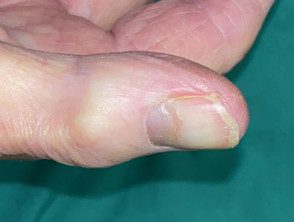What are Heberden and Bouchard nodes?
A Heberden node describes a bony swelling of the distal interphalangeal finger joint. It's a sign of osteoarthritis, a degenerative joint disease
A Bouchard's node is a similar inflammation that affects the proximal interphalangeal joint of the finger [1].
Heberden and Bouchard nodes

Heberden's and Bouchard's nodes in a patient with osteoarthritis.

Heberden's node

Heberden's node
Who has the Heberden and Bouchard nodes?
Heberdon's and Bouchard's nodes are equally common in males and females of all races.
- They are common in older people. However, more than half of patients with Heberden's nodes and osteoarthritis are diagnosed before the age of 65. [two].
- Bouchard's nodes are less common than Heberden's nodes and are associated with more severe symptoms. arthritis.
- The presence of the nodes is strongly family [1].
- More than 60% of patients with osteoarthritis of the knees have Heberden nodes. [3].
What causes Heberden's and Bouchard's nodes?
The Heberdon and Bouchard nodes are due to exostosis – an increase in bone – and are a sign of osteoarthritis. The cause of osteoarthritis is not fully understood. There's a genetic contribution to the presence of nodes [1].
Osteoarthritis is considered a sign of "wear and tear." The first structural abnormalities in osteoarthritis are evident in the ligaments that support the joints. [4]. The cartilage in the joints breaks down, osteophytes (bone spurs) develop, and the ends of the bones rub against each other.
Inflammation in ganglia is due to friction-induced capsular rupture and synovial fugue [1].
What are the clinical features of Heberden's and Bouchard's nodes?
A Heberden's node is a bony swelling of a distal interphalangeal joint and a Bouchard's node is a bony swelling of a proximal interphalangeal joint.
- Bone swelling can affect the side or middle line aspects of articulation or both [1].
- Multiple nodes can be present in one digit [2].
- the nodes can affect one or many digits.
- They most often affect the middle finger or thumb of both hands.
- They can grow slowly or quickly.
- The nodes can be swollen and painful, but are often painless and unnoticed.
- A Heberden node can be associated with a digital node myxoid pseudocyst.
In addition to affecting the fingertips, osteoarthritis causes discomfort, pain, and stiffness in other joints in the hands, knees, hips, and spine.
Digital myxoid pseudocyst

Heberdon's ganglion and myxoid pseudocyst
How are Heberden's and Bouchard's nodes diagnosed?
The diagnosis of Heberden's or Bouchard's node is usually made clinically due to its characteristic appearance. Imaging can be performed on the affected digit.
- Ultrasound scanning reveals osteophytes and synovitis [5].
- An x-ray of the affected joint often shows radiological distal interphalangeal osteophytes. Osteophytes are more common in patients who present inflammatory arthritis [6].
- Magnetic resonance imaging (Magnetic resonance) can confirm the diagnosis of arthritis in the affected finger. The formation of Heberden and Bouchard nodes is associated with Soft fabric bulging through the capsule between the dorsal tendons and collateral ligaments. The ligamentous change can be seen in adjacent but clinically normal joints [7].
Histological Examination of the Heberden or Bouchard node is not commonly performed. May show the presence of osteophytes and dorsals contractures.
X-ray findings in the nodes of Heberden and Bouchard

Radiograph of Heberden's and Bouchard's nodes
Which is the differential diagnosis for the Heberden and Bouchard nodes?
The differential diagnosis of a Heberden or Bouchard node includes [5]:
- Knuckle pad
- Proximal interphalangeal joint swelling due to rheumatoid arthritis.
- Rheumatoid nodule
- Gouty tophus
- Osler's nodes and Janeway's lesions.
- Synovial ganglion cyst
- Giant cell tumor of the tendon sheath
- Neurofibroma
-
Strange body.
How are Heberden's and Bouchard's nodes treated?
There is no specific treatment to repair Heberden and Bouchard's node.
Treatment for osteoarthritis may include lifestyle changes such as exercise, weight loss, a low-inflammation diet, heat packs, and cold packs.
Medical treatments include pain relief and non-steroidals. anti-inflammatory drugs [8].
Some patients with osteoarthritis may require surgery to repair or replace one or more joints.
